Shifting Shoreline Workshops
Posted June 21, 2017 at 5:51 am by Tim Dustrude
Understanding Sea Level Rise in the San Juan Islands
The notion of climate change driven by human emissions has been with us for a long time. In 1896, Svante Arrhenius published a paper from Denmark that applied basic chemical and physical principles to demonstrate that humans, by adding greenhouse gases to the atmosphere, could change the planet’s surface temperature. One of the climate impacts of critical importance in coastal Washington and the San Juans, sea level rise, is an outcome of increasing temperature.
Average ocean levels over long time periods (multiple decades or centuries) are controlled by climate, primarily through two relationships: First, the volume of water is related to its temperature, and if ocean water warms it also expands, raising sea levels. Next, as the temperature of the atmosphere and ocean warms, water that is currently in ice form is converted to liquid form. For ice that is perched on land, like the huge masses of ice that lie atop Greenland or Antarctica, melting leads to increased water volume in the ocean basins – raising the level of the oceans.
This climate-driven “sea level rise” poses a unique threat to communities in Washington State, which boasts over 3,000 miles of coastline, much of it developed. Sea level rise exposes our homes, infrastructure and valued coastal habitats to increasing flood risk, erosion and is likely to convert some existing developed land into tidelands. This isn’t only a future problem: A 2014 NOAA analysis of tide gauge records from Seattle shows that the average number of days of coastal flooding in and near the city have more than doubled since 1950, and are correlated with a documented rise in average sea level of just 5 inches.
Washington’s coastal communities will experience sea level rise in different ways and at different rates due to differences in how the land is moving up or down relative to the sea. Whereas past sea level rise assessments in some cases assumed uplift across the landscape of coastal Washington, more recent work shows that much of Puget Sound is not uplifting (which appears to be the case for Friday Harbor), and may even be subsiding (which appears to be the case for Seattle). These differences will almost certainly determine how a community experiences future sea level rise.
If we can provide better tools to address the critical question: “How much, and when, will sea level rise in MY community?”, we may have opportunities to apply Washington State’s coastal planning system and other actions to increase our “resilience”, or our ability to plan and prepare for the effects of sea level rise.
The Washington Coastal Resilience Project offers new technical resources for communities that will be explored in the “Shifting Shoreline Workshops” later this month:
- Lopez: Thursday June 29, 10:30 a.m. – 12:30 p.m. at Woodmen Hall
- Orcas: Thursday June 29, 5-7 p.m. at the Eastsound Fire Hall
- San Juan: Friday June 30, 11 a.m. – 1 p.m. at Brickworks.
Food and drinks provided, RSVPs appreciated at 378-2319 or tina@sanjuans.org.
Ian Miller, PhD is the Coastal Hazards Specialist at Washington Sea Grant, teaches oceanography at Peninsula College and is a principal investigator on the Washington Coastal Resilience Project. Ian lives in Port Angeles with his family.
You can support the San Juan Update by doing business with our loyal advertisers, and by making a one-time contribution or a recurring donation.
Categories: Environment











No comments yet. Be the first!
By submitting a comment you grant the San Juan Update a perpetual license to reproduce your words and name/web site in attribution. Inappropriate, irrelevant and contentious comments may not be published at an admin's discretion. Your email is used for verification purposes only, it will never be shared.